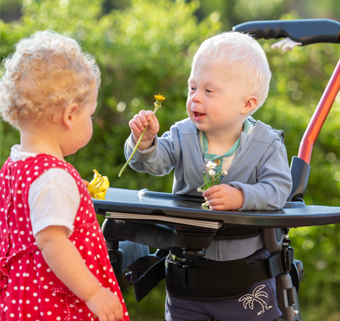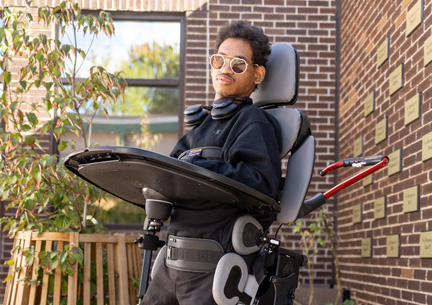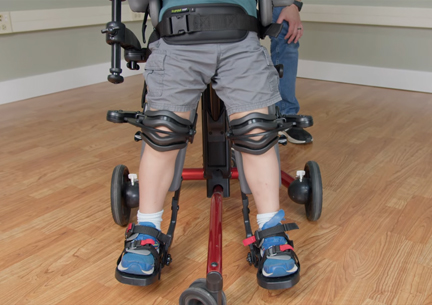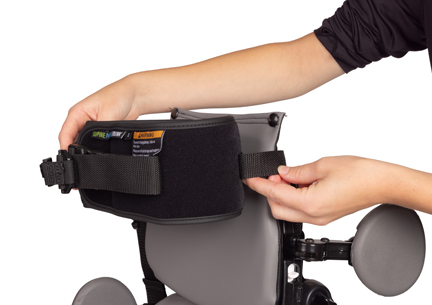Standing Tall
The Benefits of Standing Devices
| March 2007By Mark P. Warner, PT, ATP
 Pediatric physical therapy has been my career for almost fifteen years. Working in a variety of settings, including acute care, school-based therapy and outpatient rehabilitation, has allowed me to witness the benefits children with special needs gain from using assistive technology. During the past ten years, a considerable amount of my continuing education has focused on learning about assistive technology, and two years ago, I completed my RESNA certification to become an Assistive Technology Practitioner (ATP).
Pediatric physical therapy has been my career for almost fifteen years. Working in a variety of settings, including acute care, school-based therapy and outpatient rehabilitation, has allowed me to witness the benefits children with special needs gain from using assistive technology. During the past ten years, a considerable amount of my continuing education has focused on learning about assistive technology, and two years ago, I completed my RESNA certification to become an Assistive Technology Practitioner (ATP).
In my opinion, with the exception of a wheelchair, there is no other piece of assistive technology that is more beneficial to children and adults with special needs than a standing device. With the advances in technology and especially in research, assistive technology is being recognized as a necessity rather than a luxury. Children with special needs benefit in many ways from being placed in a standing device, even when a child can stand or walk on his own. Most children with special needs struggle to hold themselves up against gravity and usually do so with very poor posture. As a therapist, we are always trying to re-align asymmetrical posture because over the long–term, the child’s skeletal structure will begin to accommodate to the asymmetry, which may result in scoliosis and/or joint deformities. This may set a child up for multiple corrective surgical interventions.
Postural symmetry during standing and walking activities is extremely important for everyone. Very few children with special needs are able to sustain their body in a symmetrical standing posture for more than two or three minutes without support. Motivated parents who try to mimic the posture of their child and hold it for a few minutes quickly learn how much energy a body uses to sustain that posture and how quickly it becomes very uncomfortable. It does not matter what level of ability a child has; there are a wide variety of standers available that will meet or exceed your child’s needs, no matter what age the child is.
Many different types of standers exist, and trying to find the best stander to meet your child’s specific needs can be confusing. My recommendation to parents is to gather opinions from different therapists that interact with your child. Then seek out a supplier who is willing to work with you and your child’s therapist to do trials of different types of standers. No one knows your child better than you, the parent, so you need to be a part of this process. Parents need to look at how comfortable the child is while they are in the stander and how quickly they become fatigued. This is part of the reason why the parents need to be involved in the process.
Advice on Funding:
"Parents always ask for hints, suggestions and recommendations on how to deal with funding issues. The best advice is, do not be afraid of a fight! Get used to the idea of doing battle with payer sources to get what your child needs. I have found that, unless the piece of assistive technology is a wheelchair, most insurance companies, including Medicaid, will deny rather than approve your first attempt at funding. Appealing the denial may take more time, but if you stay the course and have the support of the supplier and therapist (who may need to write a second Letter of Medical Necessity), most of the time you will get an approval."
Mark P. Warner, PT, ATP
Standing devices are available in basically four types, and each stander has many different options. Determining which stander will work best for your child is a process, with a decision made after consideration and trial of different standers. If a therapist or a vendor has the one-type-fits-all approach, I suggest you seek out someone else. Here are brief descriptions of each type of standing device and the abilities needed by the child for the best fit possible.
Sit-to-Stand Standers. There are two types of sit-to-stand devices: a stander with a seat that requires a transfer and a “transfer-less” device, which is also referred to as a “Strap Stander.” The stander that has a seat is very functional since it can be used in sitting and standing and usually can stop at any angle between sitting and standing. A Strap Stander uses one or two straps (depending on the person’s abilities) to lift the person out of their wheelchair. This system works well for larger, heavier adolescents and adults since a transfer is unnecessary. Both types of sit-to-stand standers require head control and fair trunk control. New options have become available, including a battery-operated lift instead of a manual hydraulic pump, for those with less strength.
Prone, Supine, Multi-Position Standers. Most prone/supine standers are passive standers, meaning that the person in the stander does not control the stander’s position. Some Supine/Prone standers can be reversed so the person can be placed in either a prone (on their belly) or supine (on their back) position depending on the person’s abilities, these are often called Multi-Position Standers. These standers can be more difficult to use since they are sometimes closer to the floor, and transferring the person in the stander can require two people. Prone positioning is good for stretching out hip flexor contractures and allows the person to be challenged to do intermittent head control. However, in prone the person is in a gravity dependent position making it more difficult for functional tasks. In supine, the person is lying on their back and then transitions into an upright position until there is a balance between their head control and how much gravity pulls their bodies forward. Supine Standers are great to use with people who have a difficult time supporting themselves against gravity.
Mobile Standers. The mobile standers can offer the “best of both worlds” since you can be in the standing position while propelling yourself. There are two main types. The first is a sit-to-stand stander with a series of pulleys and wheels that allow the person to propel while in a standing position. A few companies are beginning to offer a power option--the wheels are driven by motors and the stander is controlled by a joystick similar to a power wheelchair. The second type of mobile stander looks like a prone stander with large wheels on the sides that are used to propel the stander. Mobile standers are for a specific group of people who have good head control and upper body strength. People diagnosed with spinal cord injuries, spina bifida, and cerebral palsy are some who can benefit from both the added mobility and being in a standing position.
Active Stander. The active stander is one of the newest options developed, with only one company offering active standing at this time. These sit-to-stand standers have a “glider” attachment that allows the person to use either their arms, or a combination of arms and legs, to operate the mechanism and “glide” in a reciprocal walking type pattern. Like the mobile stander, the person in the active stander needs good head control and upper body strength, unless there is caregiver assistance.
 The reason that a “standing program” works so well is really quite simple. As children develop, their bones grow quickly, and the soft tissue (muscles, tendon, ligaments, vessels and nerves) needs to “catch up” to the bone growth. Typically, this happens when children participate in normal play activities (running, jumping, riding bikes). Children with special needs usually do not have the ability to achieve a high enough activity level to stretch their muscles out. From about age six and up, children seem to grow in “chunks,” making it even more difficult for a child with special needs to get their muscle growth caught up to their bone growth. The result is a loss of range of motion (ROM) which negatively affects their functional motor skills.
The reason that a “standing program” works so well is really quite simple. As children develop, their bones grow quickly, and the soft tissue (muscles, tendon, ligaments, vessels and nerves) needs to “catch up” to the bone growth. Typically, this happens when children participate in normal play activities (running, jumping, riding bikes). Children with special needs usually do not have the ability to achieve a high enough activity level to stretch their muscles out. From about age six and up, children seem to grow in “chunks,” making it even more difficult for a child with special needs to get their muscle growth caught up to their bone growth. The result is a loss of range of motion (ROM) which negatively affects their functional motor skills.
A standing device allows children and adults with differing abilities to maintain a symmetrical standing posture for an extended period of time. This extended period of time allows the muscles to elongate and stretch, stimulating the new tissue growth needed to catch up to their bone growth. The other benefits are many and include: increased bone density, a more alert state, increased cardio-pulmonary output, and improved peer interaction. Children involved in standing programs have experienced other benefits such as regular bowel program, better head control, and more upper extremity function. It is especially important for adolescents to be involved in a standing program since their ambulation skills can begin to decrease as they get larger. At this age they are still growing and are at high risk for joint contractures.
Parents and therapists need to think “outside the wheelchair” when it comes to positioning. Unless there is an underlying medical reason that would prevent standing, every one can benefit from a standing program, especially when they cannot stand independently. My hope is to empower you, the parents, to seek out and embrace the equipment available to help keep your children safe, healthy, and interactive with their environment to the best of their abilities. I encourage parents to seek assistance of those who see the abilities of their child rather than the disabilities.
Read More… Health Benefits of Standing
Mark P. Warner, PT, ATP is a Level II Therapist, Assistive Technology Practitioner, AACBIS Certified Brain Injury Specialist and part of the Cincinnati Children's Comprehensive Outpatient Rehabilitation Team (CORT) in the Occupational/Physical Department of Cincinnati Children's Hospital Medical Center.
Exceptional Parent Magazine March 2007
EP Global Communications
551 Main Street
Johnstown, PA 15901
www.eparent.com
This article reprinted with the expressed consent and approval of Exceptional Parent, a monthly magazine for parents and families of children with disabilities and special health care needs. Subscription cost is $39.95 per year for 12 issues; Call (877) 372-7368.




